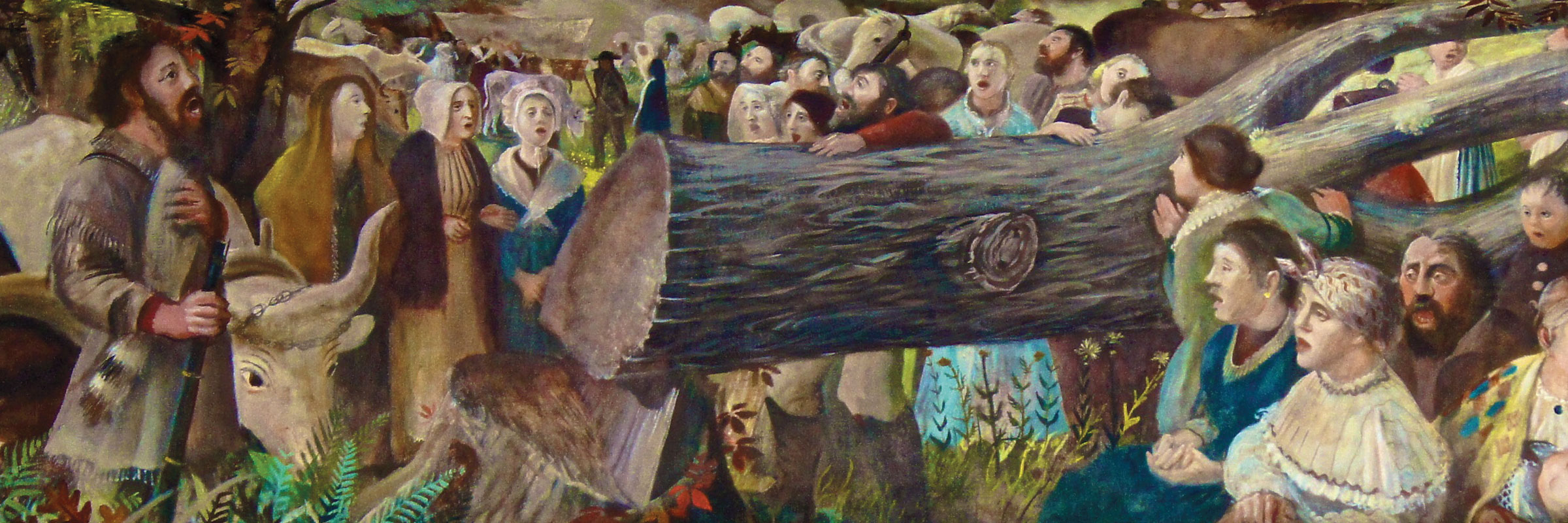The mural in the Granville Post Office (above) depicts the legend of the beech tree. According to the story, that tree stump served as the altar for the first religious services in Granville. By the 1850s, Granville had already come a long way (right), and for the town’s centennial, officials erected a marble statue of the famous stump, complete with a list of Granville’s founders.
In the cold, wet dreariness of an Ohio day in November, 1805, 93 former New Englanders came together in what would become the village of Granville. Two months earlier they had been sleeping comfortably in their beds, warm and well fed, in their homes in Massachusetts and Connecticut. Now, after six weeks of hellish cross-country travel, they were shivering in the middle of a dense and rainy forest in central Who-Knows-Where. Imagine the chilliest, soggiest camping weather you’ve ever been in, then take away the tent.
Unlike the Native Americans, recently driven out of the area, the Granvillians’ journey had been voluntary, undertaken to escape the exhausted soil and diminishing prospects of their lives in New England. The mood was nonetheless gloomy: lousy weather, no shelter, and nothing on the horizon but months of backbreaking labor to clear fields and build a village in the wilderness. The area was full of rattlesnakes, wolves, and other dangers; the closest thing resembling what they understood as civilization—the village of Zanesville—was a two-day journey away. According to later accounts, some contemplated suicide, others merely a return to Massachusetts.
Pious Puritans that they were, however, the only immediate action they took was to gather and pray. And therein lies the origin story. They cut down a beech tree near the center of what would become their new village and turned the stump of the tree into a makeshift pulpit. A sermon was delivered, prayers were spoken, hymns were sung.
According to legend, their singing was overheard by one of a handful of Welsh squatters who lived in the area, Theophilus Rees; he had been unaware that the Granvillians had come to the area, but when he heard their hymns ringing through the forest, he came closer to investigate. And although he spoke almost no English, he became an unofficial member of the congregation, even leading prayers in Welsh on occasion.
In the telling, the story of the beech tree might be somewhat lacking in the drama and fireworks department: There was a “Timber!” followed by a “Let us pray,” and really that was about the sum of it.
But those early Granvillians held on to that simple moment as a particularly important symbol of who they thought they were and what they hoped to accomplish in Ohio. And perhaps we can see why: In the humble gesture of felling a tree, this deeply religious community had begun the construction of their new village in the woods with an altar at the center. They had, in effect, turned the daunting endless forest that surrounded them, with all of its dangers and isolation and hardships, into a church that could harbor and protect their community. For them, that stump was as significant as Plymouth Rock.
As with all origin stories, of course, the details of the beech tree story are actually much messier when you start to pin them down. The earliest account we have places the location of that first open-air service on what is now the northwest corner of Main and Broadway, near the Presbyterian church. A letter from the 1880s recounting the recollection of Hiram Rose, who had been there that day, places the beech tree on the southwest corner near the Baptist church. Thus the various histories of Granville give different accounts of the tree’s whereabouts, and it is also not clear whether Theophilus Rees was really there that first day. Finally, this origin story silences the fact that many Granvillians had already been in the area for months before the November 17th service, clearing trees, building a mill, and prepping for the main party of settlers to arrive. In fact, this village in the wilderness had a makeshift tavern, selling whiskey at 25 cents a quart, a full month before the felling of the beech tree.
Despite these wrinkles in the tale, the beech tree has gone down in Granville history as the village’s founding myth. At the centennial celebration in 1905, the town erected a commemorative marble statue of the stump as a fitting tribute to their forebears, an idea that had been suggested as early as 1897. The local paper records a bit of back-and-forth trying to resolve the inconsistencies in records of the stump’s location, finally resolved in favor of the Presbyterian church location where the monument still stands. Carved in Belford, Ind., and installed by Granville’s local stone masons, the DeBow Brothers, the statue lists 27 of those first settlers and the pastors of the Congregational church in its first century.
In the 1930s, the story of the beech tree was depicted with even more drama—and perhaps some license—in the Granville Post Office at the corner of Broadway and Prospect. Entitled “First Pulpit in Granville,” the mural was painted in 1938 by Wendell Cooley Jones as part of the Works Progress Administration public arts project, and it is worth a closer look. Chosen by a committee formed by Granville’s Business Men’s Association, it is a curious image that some find full of Fellini-esque faces and odd details. But it is endlessly interesting and, together with the marble statue, has helped secure the centrality of the beech tree story to Granville’s sense of its identity and its history.
Bill Kirkpatrick is an assistant professor of communication at Denison. In addition to his academic research and publications, Kirkpatrick is also the author of The Founding of Granville, the first book in a series about the village, published by the Granville Historical Society. Kirkpatrick offers special thanks to Theresa Overholser of the Historical Society for her help with this story.

